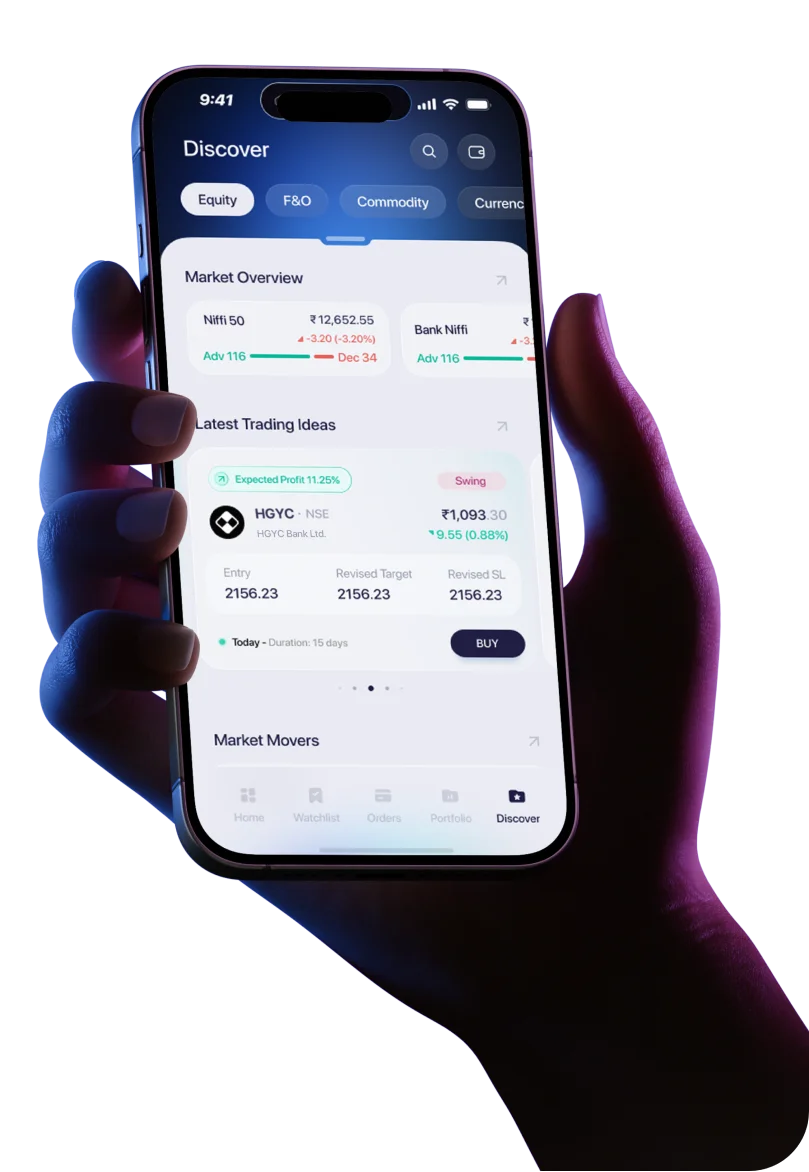In this article, we will discuss
- What is the Protective Put?
- The Objectives of the Protective Put Strategy
- How to Implement the Protective Put Strategy?
- The Protective Put: An Example
- Pros and Cons of the Protective Put
- Make the Most of the Protective Put with the Samco Trading App
Options trading strategies do not always involve complex, multi-legged trades. Sometimes, a position can be hedged merely by initiating one single trade in the opposite direction. Protective options strategies belong to this category of trades. Two of the simplest and most common protective options trades are the protective put and the protective call.
In this article, we dissect the protective put, understand how and when to execute it and discuss the possible outcomes.
What is the Protective Put?
The protective put strategy, also known as the married put or synthetic call, is a simple risk-management technique that uses put options. It is best used when you already own the underlying stock or asset in your portfolio. While you may expect the price of this asset to likely increase in the future, you may always want to protect yourself from the downside risk if the market moves in the opposite direction and the price falls instead.
Here is where the protective put can be useful. To hedge your long position in the asset, you can buy a put option with that stock or security as the underlying. This way, you can benefit if the price of the asset rises as expected but you are still protected by the put option if the asset price moves unfavourably and declines instead.
The Objectives of the Protective Put Strategy
The protective put strategy can be implemented using an options strategy builder to meet any of the following objectives:
- To limit the downside risk when you are purchasing a stock or security
- To safeguard against price declines in any stock or security that you already hold, especially if its long-term outlook is bullish but its short-term trend is bearish
So, irrespective of whether you already own the underlying asset or you want to open a new long position, you can use the protective put to limit the risk in your trade.
How to Implement the Protective Put Strategy?
Implementing the protective put strategy is extremely simple. The steps involved include the following:
-
Identify the Position that You Wish to Protect
Start by identifying the long position that you want to secure using the protective put. This may either be a stock or asset that you already hold, or an asset that you intend to purchase. Whichever the case, it is important that the price of the asset should be bullish and the probability of the price rising over the long term should be fairly high.
-
Buy a Protective Put
Although the outlook for the stock or asset may be largely bullish, you may still want to protect yourself against the downside risk if the price falls unexpectedly. So, you buy a protective put option with the same stock or security as the underlying asset. The expiry date for this put should typically align with the period over which you expect the bearish price movement, so your long position is appropriately protected.
As for the strike price, it depends entirely on how much downside risk you are willing to bear. An at-the-money (ATM) put option offers you 100% protection till the expiry date because the strike price equals the asset price. However, ATM options are expensive.
If you want to reduce the upfront cost of the hedge and are willing to withstand some degree of downside risk, you could choose an out-of-the-money (OTM) put option instead. This does not give you 100% downside protection but instead, it limits your loss to the difference between the asset’s purchase price and the option’s strike price.
The Protective Put: An Example
Let us discuss a hypothetical example to understand how the protective put strategy works. Say you purchase 100 shares of a company at Rs. 500 each. You are bullish on this stock and expect its price to increase over the long term because of strong fundamentals.
However, you also want to safeguard your position against any potential price decline, especially over the short term. So, you decide to purchase a put option to hedge the long position. Now, say you are willing to risk a downside of 5% in the stock’s price — up to Rs. 475. This means you should purchase an OTM put option with a strike price of Rs. 475.
For the sake of our example, let us assume the put option has a lot size of 100 shares and is trading at a premium of Rs. 2 per share. To hedge your long position, you need to purchase just one lot of the put option at a total premium of Rs. 200 (i.e. Rs. 2 x 100 shares per lot).
To summarise:
- Stock purchase price = Rs. 500 per share
- Number of stocks purchased = 100 shares
- Put option strike price = Rs. 475
- Lot size = 100 shares
- Premium paid = Rs. 2 per share or Rs. 200 in total
-
Scenario 1: The Stock Price Rises at Expiry
Say your bullish outlook was valid and the stock price rises to Rs. 520 at expiry. In this case, the put option expires worthless and you lose the premium paid for it. However, this loss is set off entirely by the profit from the long position, leading to a net gain as calculated below:
The Outcome of the Long Position in the Cash Market:
= [(Spot Price at Expiry — Purchase Price) x 100 shares] — Total Premium Paid
= [(Rs. 520 — Rs. 500) x 100 shares] — Rs. 200
= Rs. 2,000 — Rs. 200
= Rs. 1,800 profit
-
Scenario 2: The Stock Price Falls at Expiry
Assume the stock price is bullish over the short term and declines to Rs. 462 at expiry. In this case, your long position in the cash market is at a loss of Rs. 38 per share (i.e. Rs. 500 — Rs. 462). The total loss in this long position is Rs. 3,800 for 100 shares.
However, your put option is profitable and can help you set off some of this loss. The profit from the put option can be calculated as shown below.
The Outcome of the Long Put:
= [(Strike Price — Spot Price at Expiry) x 100 shares] — Total Premium Paid
= [(Rs. 475 — Rs. 462) x 100 shares] — Rs. 200
= Rs. 1,300 — Rs. 200
= Rs. 1,100 profit
This offsets the earlier loss and reduces it to Rs. 2,700 (i.e. Rs. 3,800 — Rs. 1,100).
Pros and Cons of the Protective Put
Before you implement the protective put using an options strategy builder, you must know its upsides and downsides.
The key benefits of the protective put strategy include:
- Effective downside protection
- No cap on the profits
- Flexibility to choose the put strike based on risk tolerance
However, it also has some limitations, such as:
- Limited duration of protection (only till expiry)
- The additional cost of purchasing the put
Make the Most of the Protective Put with the Samco Trading App
Although the protective put is a simple trade, you need to implement it at the most opportune moment to ensure it is effective. Manually analysing the market and finding a suitable entry point is not only time-consuming but can also be prone to human errors. Here is where the Samco trading app can be a game-changing tool for traders.
Equipped with a host of advanced analytical features and live market data, the Samco trading app makes options trading effective and potentially more successful for users. The newest addition to this repertoire of tools is Samco’s proprietary options strategy builder, which uses a few key details to filter through 1,000+ strategies and pinpoint the top three trading techniques for users with different risk profiles.
Aptly named Options B.R.O, this options strategy builder, which is integrated seamlessly into the Samco trading app, helps you build, research and optimise different trading strategies thoroughly. If you wish to implement the protective put to safeguard yourself from the downside risk in a potentially bullish market, you can use this options strategy builder to execute the strategy within seconds, thanks to Samco’s one-click trade feature.
To access all these features and more for free, open a Samco demat account and trading account online seamlessly today.
Disclaimer: INVESTMENT IN SECURITIES MARKET ARE SUBJECT TO MARKET RISKS, READ ALL THE RELATED DOCUMENTS CAREFULLY BEFORE INVESTING. The asset classes and securities quoted in the film are exemplary and are not recommendatory. SAMCO Securities Limited (Formerly known as Samruddhi Stock Brokers Limited): BSE: 935 | NSE: 12135 | MSEI- 31600 | SEBI Reg. No.: INZ000002535 | AMFI Reg. No. 120121 | Depository Participant: CDSL: IN-DP-CDSL-443-2008 CIN No.: U67120MH2004PLC146183 | SAMCO Commodities Limited (Formerly known as Samruddhi Tradecom India Limited) | MCX- 55190 | SEBI Reg. No.: INZ000013932 Registered Address: Samco Securities Limited, 1004 - A, 10th Floor, Naman Midtown - A Wing, Senapati Bapat Marg, Prabhadevi, Mumbai - 400 013, Maharashtra, India. For any complaints Email - grievances@samco.in Research Analysts -SEBI Reg.No.-INHO0O0005847



 Easy & quick
Easy & quick
Leave A Comment?